|
 |
| Adult with orange breeding color, San Diego County |
 |
 |
 |
| Adult with orange breeding color, San Diego County |
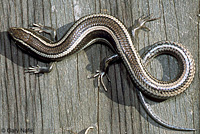 |
 |
 |
| Adult, San Diego County |
Adult, San Diego County |
 |
 |
 |
| Adult, underside, San Diego County |
Sub-adult, San Diego County |
Adult, San Diego County |
 |
 |
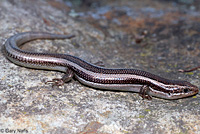 |
| Adult, San Diego County © Dan Boyd |
This skink was found underneath a rock, lying on top of her eggs, in San Diego County. © Ryan Sikola. |
Adult, San Diego County |
 |
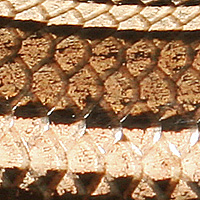 |
|
Adult Coronado Skink, San Diego County © Jack
You can see in this distant shot how much the blue tail on a skink stands out. The light stripes and dark background on the head and body tend to blend into the background making them less noticeable. When a skink with a blue tail is running, it can look like there is a small bright blue snake wriggling instead of a lizard. That will attract the eye of a predator. But unlike the body, the tail is expendable. If a predator grabs it, it will come off easily but it will still move as if it is alive to distract the predator while the rest of the lizard gets away unharmed. |
Toothy Skinks, genus Plestiodon, have smooth shiny cycloid scales that are reinforced with bone. Plestiodon skiltonianus is shown here.
|
|
| |
|
|
| Juveniles |
 |
 |
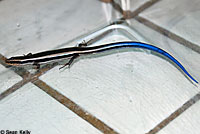 |
Juvenile, found in and pulled out of a swimming pool in
San Diego County. © Sean Kelly |
Another juvenile, found in and pulled out of a swimming pool in San Diego County.
© Sean Kelly |
 |
|
|
Juvenile, San Diego County
© John T. Snow |
|
|
| Identification of the Two Subspecies of Plestiodon skiltonianus |
 |
 |
|
The majority of Skilton Skinks -
P. s. skiltionianus, have an interparietal scale that is not enclosed by the parietal scales (Tanner 19571 ). |
The majority of Coronado Island Skinks - P. s. interparietalis, have an interparietal scale that is enclosed by the parietals scales (Tanner 19571 ). |
|
| |
|
|
| Comparison of Western Skinks with Gilbert's Skinks (Plestiodon skiltonianus and Plestiodon gilberti) |
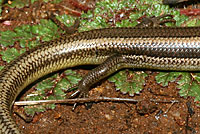 |
 |
|
Note that the dark stripes on the sides of the tail on the Western Skink extend far onto the tail past the rear legs, unlike the stripes on juvenile Gilbert's Skinks.
Compare the two species
More information about the differences between Gilbert's Skinks and Western Skinks. |
Western Skinks usually have 7 supralabial scales.
Compare with Gilbert's Skinks, which usually have 8 supralabials. |
|
| |
|
|
| Short Videos of Western Skinks - (Northwestern Skink Subspecies) |
 |
 |
 |
A skink is found under a rock. It bites hard, refusing to let go, then finally runs through dry grass with typical serpentine motion.
|
A juvenile skink loses its blue tail, which writhes around on the ground. This is a defensive measure used to distract the predator which caused the tail to become detached from the rest of the lizard as it tries to escape. |
In this video you can see how the blue tail on a juvenile skink stands out when the lizard moves, especially when it uses its stripes to blend into the vegetation. A predator is more likely to go for the tail, which can detach without hurting the lizard. |
| |
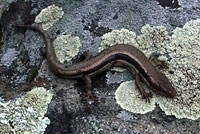 |
|
| |
A big adult skink found under a rock in winter in Contra Costa County. |
|
| |
|
|
| Habitat |
 |
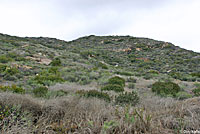 |
 |
Habitat, coastal sage scrub hilltop,
San Diego County
|
Habitat, coastal valley, San Diego County |
Habitat, coastal valley, San Diego County |
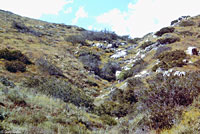 |
 |
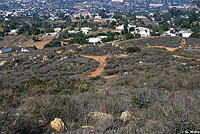 |
| San Diego County coastal sage habitat |
Habitat, 5,500 ft. San Diego County |
Habitat, hill next to suburbs,
San Diego County |
|
|
|
| Description |
| |
| Size |
2.12 - 3.4 inches long from snout to vent (5.4 - 8.6 cm) (Stebbins 2003)
Approximately 7.5 inches in total length.
|
| Appearance |
A small skink with a slim body, small head, thick neck, small legs, and a smooth, shiny body with cycloid scales.
During the breeding season, adults develop reddish orange coloring on the side of head, chin, on the tail, and sometimes the sides. |
| Color and Pattern |
Striped with 3 dark brown and light cream stripes:
A wide dark brown stripe, edged with black, extends from the nose to the tail down the middle of the back,
bordered by two pale stripes which extend from the nose over the eye to the tail.
Two more very dark stripes extend down each side through the eyes, to the tail, where they extend well out onto the tail.
Two more pale stripes extend below these dark side stripes.
The underside is pale or gray.
The tail is gray or dull blue on older adults. Younger adults often retain some of the bright blue coloring.
|
| Young |
Tail is bright blue on juveniles.
The stripes on juveniles are more highly contrasted than on adults, whose juvenile colors fade as they age.
|
| Characteristics of Subspecies of Plestiodon skiltonianus (from Tanner 19571 ) |
P. s. interparietalis - Coronado Skink
"Interparietal enclosed by the parietals in 80 per cent of the population.
Stripes of the body pattern extended onto anterior half or more of tail."
"The extension of the striped pattern on the tail is also seen in specimens of skiltonianus from the coastal ranges of California. However, specimens from north of San Diego County are generally less obviously striped on the tail and if so then with only an occasional one having the interparietal enclosed."
"Diagnosis: this form is most closely related to typical skiltonianus with which it intergrades in San Diego and Riverside counties California. It is different to all other skiltonianus in having the interparietal reduced in size and enclosed posteriorly by the parietals,
the medial and lateral dark stripes extend from the body to or beyond the middle of the tail."
P. s. skiltonianus - Northwestern Skink
"Interparietal rarely enclosed by the parietals. Usually less than 10 per cent even in Los Angeles and San Bernardino Counties; and/or stripes of body pattern not extended on more than the base of the tail."
P. s. utahensis - Great Basin Skink
"Dorsolateral stripe occupying more than half of the second scale row and being nearly one half the diameter of the dark dorsal interspace.
Dark stripe below lateral light stripe rarely present.
Diameter of the dorsolateral stripe usually greater than the length of the first nuchal."
|
| Identifying Skinks in California - Differences between Western Skinks and Gilbert's Skinks (Plestiodon skiltonianus and Plestiodon gilberti) |
| |
| Life History and Behavior |
Activity |
Diurnal, but secretive and not typically seen active.
Occasionally seen foraging in leaf litter.
More commonly found underneath bark and surface objects, especially rocks, where it lives in extensive burrows.
Inactive in cold weather.
|
| Defense |
The tail is easily broken off.
When detached, it writhes back and forth to distract a predator while the lizard escapes.
The lizard will grow a new tail.
The bright blue coloring on the tail of a juvenile skink tends to distract a predator from the main body of the lizard.
Sometimes only the blue tail can be seen as the lizard rushes through grass or leaves.
Occasionally the blue tail is mistaken for a small blue snake.
More information about tail loss and regeneration. |
| Diet and Feeding |
| Insects, and other small invertebrates, especially spiders and sow bugs. |
| Reproduction |
Females lay 2 - 10 eggs in June and July.
Females guard their eggs until they hatch. Maternal care such as this is rare in lizards.
Eggs
hatch in late July and August.
|
| Habitat |
Grassland, woodlands, pine forests, chaparral, especially in open sunny areas such as clearings and the edges of creeks and rivers. Prefers rocky areas near streams with lots of vegetation. Also found in areas away from water.
|
| Geographical Range |
This subspecies is found in inland Southern California south through the north Pacific coast region of northern Baja California Norte.
The species Plestiodon skiltonianus ranges beyond California north into inland British Columbia, east into Idaho, Nevada, Utah, and north-central Arizona, and south to the southern tip of Baja California.
1 Tanner, in his1957 description of the subspecies, describes the range as
"North and western Baja California including the Coronado and Todos Santos Islands, and southern San Diego County, California."
Specimens examined in the study are described below, but he does not say which of the examined specimens keyed out to interparietalis.
Riverside County: San Jacinto, Andreas Canyon S of Palm Springs; Snow Creek; Palm Springs.
San Diego County: Barona Ranch Alpine, Dulzura, El Capitan, Laguna Mts, San Diego, Palomar Mts
He describes some intergrade areas: "Intergrades skiltonianus x interparietalis;
San Diego Co.: Escondido; Oceanside; Poway."
Based on that information, my map shows a wide intergrade area from Oceanside northeast across the range into Riverside County down to Poway. That's the best I can do with the information given until I find more information or they get rid of the subspecies (which is more likely to happen.)
To further confuse the issue, I have reproduced a detail of the localities map from 2 Jennings and Hayes,1994 study of California Species of Special Concern. They show P. s. interparietalis present in a large area of Riverside County.
|
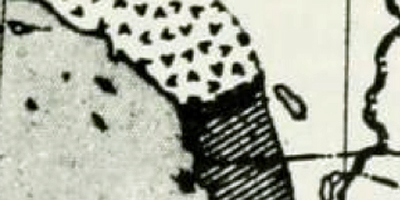
|
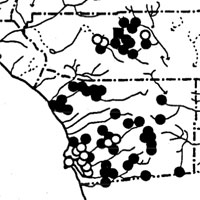 |
Range map showing subspecies skiltonianus (boomerangs - top) and interparietalis (stripes - bottom).
This appears to be the basis of most of the range maps showing where the two subspecies meet in San Diego and Riverside Counties. 1 Tanner 1957
(Click map for a larger version)
|
Localities for E. s. interparietalis from
2 Jennings and Hayes,1994.
(Click map for a larger version)
|
 |
| Elevational Range |
From sea level up to around 8,300 ft. (2,530 meters).
|
| Notes on Taxonomy |
Several subspecies of Plestiodon skiltonianus are recognized, with three found in California: P. s. interparietalis, P. s. skiltonianus, and P. s. utahensis.
----------------------------------------------------------------------------------------------------------------------------------------------------------------------
P. s. interparietalis might be a unique species.
According to the taxonomic notes in Hansen and Shedd, 2025:
Coronado Skink (P. s. interparietalis) is a genetically distinct form that appears to forma a narrow hybrid zone with P. s. skiltonianus in Riverside Co. (Richmond et al, unpublished data). It is deeply differentiated with respect to other populations of P. skiltonianus and forms a sister lineage to the San Lucan Skink (P. lagunensis) of the Cape Region of Baja California Sur. This pattern is one of separately evolving lineages that are now in secondary contact, with only limited gene exchange, and suggests that P. s. interparietalis warrants species status.
----------------------------------------------------------------------------------------------------------------------------------------------------------------------
"Type: California Academy of Sciences No. 13576, an adult male, collected on South Coronado Island, Baja California 7 April 1908, by Rollo Beck." 1 Tanner,1957
----------------------------------------------------------------------------------------------------------------------------------------------------------------------
Some taxonomists do not recognize the southern California subspecies P. s. interparietalis. They group it with
P. s. skiltonianus.
----------------------------------------------------------------------------------------------------------------------------------------------------------------------
Brandley et al. (2005 Syst. Biol. 54:373-390) replaced Eumeces with Plestiodon.
----------------------------------------------------------------------------------------------------------------------------------------------------------------------
In 2008 the Society for the Study of Amphibians and Reptiles adopted the use of Plestiodon (instead of Eumeces) in the sixth edition of their Scientific and Standard English Names of Amphibians and Reptiles of North America north of Mexico list.
----------------------------------------------------------------------------------------------------------------------------------------------------------------------
"Because the relationships within E. skiltonianus and between E. skiltonianus and the lineages within E. gilberti are complicated (Richmond and Reeder, 2002, Evolution 56: 1498–1513) and need to be analyzed using nuclear markers, we have retained the previously recognized subspecies as legacy taxa."
(Nicholson, K. E. (ed.). 2025 SSAR Scientific and Standard English Names List)
----------------------------------------------------------------------------------------------------------------------------------------------------------------------
Alternate and Previous Names (Synonyms)
Eumeces skiltonianus skiltonianus - Skilton's Skink (Stebbins 2003)
Eumeces skiltonianus interparietalis - Coronado Island Skink (Stebbins 1966)
Eumeces skiltonianus - Common Western Skink (Smith 1946)
Plestiodon skiltonianum - Western Skink (Eumeces quadrilineatus; Eumeces gilberti; Eumeces skiltonianus var. brevipes; Eumeces hallowellii; Eumeces skiltonianus var. amblygrammus; Eumeces skiltonianus. Blue-tailed Lizard; Skilton's Skink; Red-headed Skink; Gilbert's Skink; Blue-tailed Skink) (Grinnell and Camp 1917)
|
| Conservation Issues (Conservation Status) |
| A California species of special concern due to habitat loss. |
|
|
Taxonomy |
| Family |
Scincidae |
Skinks |
Gray, 1825 |
| Genus |
Plestiodon (formerly Eumeces) |
Toothy Skinks |
Duméril and Bibron, 1839 |
| Species |
skiltonianus |
Western Skink |
Baird and Girard, 1852 |
Subspecies
|
interparietalis |
Coronado Skink |
(Tanner, 1958 “1957”) |
|
Original Description |
Eumeces skiltonianus - (Baird and Girard, 1852) - Proc. Acad. Nat. Sci. Philadelphia, Vol. 6, p. 69
Eumeces skiltonianus interparietalis - Tanner, "1957" 1958 - Great Basin Naturalist, Vol. 17, p. 73
from Original Description Citations for the Reptiles and Amphibians of North America © Ellin Beltz
The Common Name "Coronado Skink" refers to the origin of the type specimen:
Type: California Academy of Sciences No. 13576, an adult male, collected on South Coronado Island, Baja California, Mexico, 7 April 1908, by Rollo Beck.
|
|
Meaning of the Scientific Name |
Plestiodon (Toothy Skinks) - Greek - pleistos = most + odontos = teeth
skiltonianus - honors Skilton, Avery J. (American naturalist who sent specimens to Baird and Girard.)
interparietalis - Latin - inter = between + parietalis = (refers to the interparietal scale of this subspecies being enclosed by the parietal scales, unlike the scale on other subspecies.)
from Scientific and Common Names of the Reptiles and Amphibians of North America - Explained © Ellin Beltz
|
|
Related or Similar California Lizards |
P. g. cancellosus - Variegated Skink
P. g. gilberti - Greater Brown Skink
P. g. placerensis - Northern Brown Skink
P. g. rubricaudatus - Western Red-tailed Skink
P. s. skiltonianus - Northwestern Skink
P. s. utahensis - Great Basin Skink
|
|
More Information and References |
California Department of Fish and Wildlife
1 Tanner, Wilmer W. A taxonomic and ecological study of the western skink (Eumeces skiltonianus). Great Basin Naturalist 17:59-94 1957.
2 Mark R. Jennings, and Marc P. Hayes. Amphibian and Reptile Species of Special Concern in California.
California Department of Fish and Game study, 1994
Lemm, Jeffrey. Field Guide to Amphibians and Reptiles of the San Diego Region (California Natural History Guides). University of California Press, 2006.
Hansen, Robert W. and Shedd, Jackson D. California Amphibians and Reptiles. (Princeton Field Guides.) Princeton University Press, 2025.
Stebbins, Robert C., and McGinnis, Samuel M. Field Guide to Amphibians and Reptiles of California: Revised Edition (California Natural History Guides) University of California Press, 2012.
Stebbins, Robert C. California Amphibians and Reptiles. The University of California Press, 1972.
Flaxington, William C. Amphibians and Reptiles of California: Field Observations, Distribution, and Natural History. Fieldnotes Press, Anaheim, California, 2021.
Nicholson, K. E. (ed.). 2025. Scientific and Standard English Names of Amphibians and Reptiles of North America North of Mexico, with Comments Regarding Confidence in Our Understanding. Ninth Edition. Society for the Study of Amphibians and Reptiles. [SSAR] 87pp.
Samuel M. McGinnis and Robert C. Stebbins. Peterson Field Guide to Western Reptiles & Amphibians. 4th Edition. Houghton Mifflin Harcourt Publishing Company, 2018.
Stebbins, Robert C. A Field Guide to Western Reptiles and Amphibians. 3rd Edition. Houghton Mifflin Company, 2003.
Behler, John L., and F. Wayne King. The Audubon Society Field Guide to North American Reptiles and Amphibians. Alfred A. Knopf, 1992.
Robert Powell, Roger Conant, and Joseph T. Collins. Peterson Field Guide to Reptiles and Amphibians of Eastern and Central North America. Fourth Edition. Houghton Mifflin Harcourt, 2016.
Powell, Robert., Joseph T. Collins, and Errol D. Hooper Jr. A Key to Amphibians and Reptiles of the Continental United States and Canada. The University Press of Kansas, 1998.
Bartlett, R. D. & Patricia P. Bartlett. Guide and Reference to the Turtles and Lizards of Western North America (North of Mexico) and Hawaii. University Press of Florida, 2009.
Jones, Lawrence, Rob Lovich, editors. Lizards of the American Southwest: A Photographic Field Guide. Rio Nuevo Publishers, 2009.
Smith, Hobart M. Handbook of Lizards, Lizards of the United States and of Canada. Cornell University Press, 1946.
Joseph Grinnell and Charles Lewis Camp. A Distributional List of the Amphibians and Reptiles of California. University of California Publications in Zoology Vol. 17, No. 10, pp. 127-208. July 11, 1917.
|
|
|
The following conservation status listings for this animal are taken from the April 2024 State of California Special Animals List and the April 2024 Federally Listed Endangered and Threatened Animals of California list (unless indicated otherwise below.) Both lists are produced by multiple agencies every year, and sometimes more than once per year, so the conservation status listing information found below might not be from the most recent lists. To make sure you are seeing the most recent listings, go to this California Department of Fish and Wildlife web page where you can search for and download both lists:
https://www.wildlife.ca.gov/Data/CNDDB/Plants-and-Animals.
A detailed explanation of the meaning of the status listing symbols can be found at the beginning of the two lists. For quick reference, I have included them on my Special Status Information page.
If no status is listed here, the animal is not included on either list. This most likely indicates that there are no serious conservation concerns for the animal. To find out more about an animal's status you can also go to the NatureServe and IUCN websites to check their rankings.
Check the current California Department of Fish and Wildlife sport fishing regulations to find out if this animal can be legally pursued and handled or collected with possession of a current fishing license. You can also look at the summary of the sport fishing regulations as they apply only to reptiles and amphibians that has been made for this website.
The California Special Animals List shows the status of the subspecies Plestiodon skiltonianus interparietalis, not the full species.
|
| Organization |
Status Listing |
Notes |
| NatureServe Global Ranking |
G5T5 |
Secure
|
| NatureServe State Ranking |
S2S3 |
Imperiled-Vulnerable
|
| U.S. Endangered Species Act (ESA) |
None |
|
| California Endangered Species Act (CESA) |
None |
|
| California Department of Fish and Wildlife |
WL |
Watch List |
| Bureau of Land Management |
S |
Sensitive |
| USDA Forest Service |
None |
|
| IUCN |
None |
|
|
|






































